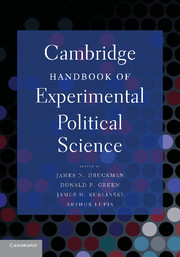Book contents
- Frontmatter
- Contents
- List of Tables
- List of Figures
- Contributors
- Acknowledgments
- INTRODUCTION
- PART I DESIGNING EXPERIMENTS
- PART II THE DEVELOPMENT OF EXPERIMENTS IN POLITICAL SCIENCE
- PART III DECISION MAKING
- PART IV VOTE CHOICE, CANDIDATE EVALUATIONS, AND TURNOUT
- 13 Candidate Impressions and Evaluations
- 14 Media and Politics
- 15 Candidate Advertisements
- 16 Voter Mobilization
- PART V INTERPERSONAL RELATIONS
- PART VI IDENTITY, ETHNICITY, AND POLITICS
- PART VII INSTITUTIONS AND BEHAVIOR
- PART VIII ELITE BARGAINING
- PART IX ADVANCED EXPERIMENTAL METHODS
- AFTERWORD
- Name Index
- Subject Index
- References
13 - Candidate Impressions and Evaluations
Published online by Cambridge University Press: 05 June 2012
- Frontmatter
- Contents
- List of Tables
- List of Figures
- Contributors
- Acknowledgments
- INTRODUCTION
- PART I DESIGNING EXPERIMENTS
- PART II THE DEVELOPMENT OF EXPERIMENTS IN POLITICAL SCIENCE
- PART III DECISION MAKING
- PART IV VOTE CHOICE, CANDIDATE EVALUATIONS, AND TURNOUT
- 13 Candidate Impressions and Evaluations
- 14 Media and Politics
- 15 Candidate Advertisements
- 16 Voter Mobilization
- PART V INTERPERSONAL RELATIONS
- PART VI IDENTITY, ETHNICITY, AND POLITICS
- PART VII INSTITUTIONS AND BEHAVIOR
- PART VIII ELITE BARGAINING
- PART IX ADVANCED EXPERIMENTAL METHODS
- AFTERWORD
- Name Index
- Subject Index
- References
Summary
For citizens to responsibly exercise one of their primary democratic duties, namely, voting, two preliminary psychological processes must occur. First, citizens must learn something about the candidates, that is, come to some understanding, even if amorphous, about the candidates' characteristics and priorities. Second, citizens must reach a summary judgment about the candidates. There is a long and distinguished history of scholarly studies of the linked processes of voting, perceptions of candidates, and evaluations of them. In his recent review of the voting behavior literature, Bartels (2010) notes, “The apparent failure of causal modeling [of observational data] to answer fundamental questions about voting behavior produced a variety of disparate reactions” (240), including scholars turning to experimentation to better understand these basic processes. My goal in this chapter is to outline experimental work that has contributed to our understanding of citizens' impressions and evaluations of political candidates, as well as to identify questions that future experiments might answer.
Clarification of Basic Concepts
Two sets of conceptual distinctions should be made clear at the outset. First, the chapter title distinguishes between candidate impressions and evaluations. By “impressions,” I mean an individual's mental representation – the cognitive structure stored in memory – consisting of knowledge and beliefs about another person. “Evaluation,” in contrast, refers to a summary global judgment ranging from very negative to very positive.
- Type
- Chapter
- Information
- Cambridge Handbook of Experimental Political Science , pp. 187 - 200Publisher: Cambridge University PressPrint publication year: 2011
References
- 17
- Cited by



